Late Roman Capital
Constantinople (Κωνσταντινούπολις) or Byzantium (Βυζάντιον): Greek city on the Bosphorus, capital of the Byzantine Empire, modern İstanbul.
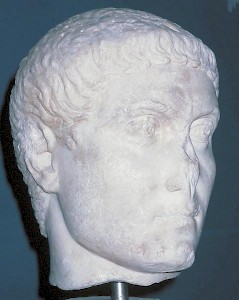
Constantine the Great had developed Byzantium to the west and had reconstructed the area of Augusteôn Square. The city was now slowly expanding. Indications for this growth can be found during the reign of Constantius II, who succeeded his father Constantine in 337: new cisterns were dug and grain silos (horrea) were built. In 359, the system of city government was changed. The man in charge no longer was a proconsul but a praefectus (eparchos), who was also in charge of the corn dole (annona). We do not know why the system was changed, but it may have had something to do with the expansion of the city.
In the next year, the church of the Divine Wisdom, the Hagia Sophia, was completed. At this moment, the year 360, the triumph of Christianity seemed certain, although there were always theological disputes that the bishops had to discuss. During the reign of Julian the Apostate (361-363), a last attempt was made to reintroduce paganism, but it was too late. More successful was another measure of Julian: he built a port for grain ships, which arrived from Egypt. It was near the modern ferry port, along the southern waterfront.
Julian was succeeded by Jovian, who never visited his capital, and Valens, who again had to cope with the increasing population. The building of new horrea is recorded, and we know about repairs to the aqueduct that had been built by Hadrian. It is now called Aqueduct of Valens and is one of the city's landmarks. It feeds a cistern built by Valens' successor Theodosius I.
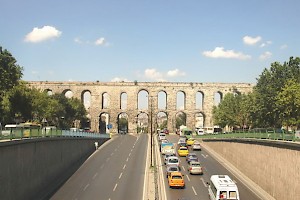
During the reign of Valens, the Visigoths started to penetrate the Empire, and the emperor himself was defeated and killed in the Battle of Adrianople (378). The invaders, however, could not scale the walls of Constantinople, and in the end, they moved to the west and for some time lived a quiet life, as long as Theodosius I was in charge.
The city continued to grow and may have had as many as 150,000 inhabitants. We read about a new cistern (above) and the improvement of one of the markets, the Forum Tauri - which was from now on known as the Forum of Theodosius (modern Beyazıt Square). Two bathhouses, named after the emperor's sons Honorius and Arcadius, were also built. In the southwest, a new part was added to the city, called Kainopolis. It was outside the walls, along the Via Egnatia, and may have stretched forward for almost 2½ km, until a triumphal arch that was known as Golden Gate. Here was also the Hebdomon, where the emperor could receive and inspect his troops. Finally, the obelisk in the hippodrome must be mentioned: it was brought in from Karnak in Egypt, and erected in Constantinople in 390. It is still standing.
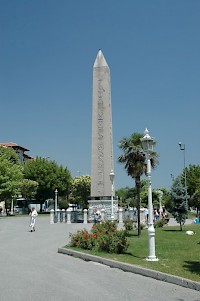
One of the main political issues of those days was the establishment of orthodox, Christian teaching. Although Constantine had decreed that all Christians should adhere to the Nicene Creed, the condemned teachings of Arius had resurfaced during the reigns of Constantius II and Valens. In 381, Theodosius organized the Second Ecumenical Council in the church of the Divine Peace, which confirmed the Nicene Creed. A decade or so later, paganism was officially forbidden, which essentially made the type of Christianity that was summarized in the Nicene Creed state religion. By then, the old temples on the acropolis, dedicated to Artemis, the Sun, and Aphrodite, had already found new purposes (as a gaming hall, a courtyard, and the carriage house of the praetorian prefect).
Theodosius died in 395, and the new ruler of the eastern part of the Empire was his son Arcadius. The city may now have had more than 200,000 inhabitants, and our sources mention a "cistern of Arcadius". During his reign, the Germanic troops of Gainas were briefly extremely powerful, but they were expelled when the population of Constantinople revolted. (This incident is behind the Egyptian Tale by Synesius of Cyrene.) Once the Germans were put away, Arcadius erected for himself a honorific column on the forum that was named after him.
Other buildings from this age are the residences of the empresses. The Notitia Urbis Constantinopolitanae states that Galla Placidia, a sister of Arcadius, owned two mansions and a palace. The emperor's wife Aelia Eudoxia I and their daughter Pulcheria are also recorded as owners of large houses.
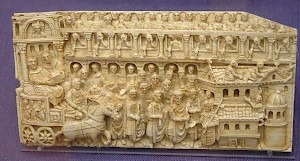
In 403-404, a conflict among the Christian leaders became uncontrollable. The patriarch of Constantinople, John Chrysostom, and his colleague in Alexandria, Theophilus, quarreled, and in the end, John was sent into exile. Almost immediately, there was a fire in the Hagia Sophia and the nearby Senate. Many classical sculptures were destroyed. It was widely believed to have been a sign of divine displeasure.
Rebuilding the church was left to Arcadius' son Theodosius II, who was still a child when his father died in 408. His elder sister Pulcheria was the real ruler of the eastern half of the Roman Empire, and she was responsible for the new Hagia Sophia, which was destroyed a century later. Another important building project was undertaken by the praetorian prefect Anthemius: the famous Theodosian Land Walls, with almost hundred towers. Construction started in 412, and in 414 the job was already finished. The city now measured 12 km² and included three new hills, bringing the grand total to seven. The water supply was improved by building the Aetius Cistern, close to the new walls. Thirty years later, the walls were to be improved by praetorian prefect Cyrus of Panopolis: a second wall was built in front of the original wall, and the number of towers was doubled - there were now 192 of them. In the mean time, the Sea Walls had been improved too.
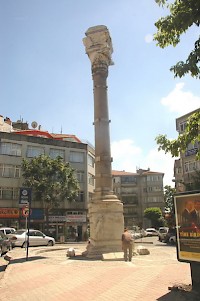
During the reign of Marcian (450-457), the Council of Chalcedon took place, which again clarified some doctrinal points. One of them is that it clarified the ecclesiastical hierarchy, conforming that the patriarch of Constantinople was the leader of all bishops in the eastern half of the Roman Empire; only the bishop of Rome was superior in rank.The only remaining monument from this period is the Column of Marcian.
One gets the impression that the days of urban growth were over. During the reign of Leo I (457-474), only the construction of cistern of Aspar suggests that the population was growing. The church and monastery of Saint John of Studius, at walking distance from the Golden Gate, is the only other monument recorded from this period. It was to be one of the most important centers of the Byzantine world. Still, it seems that that construction activity was almost absent; from the reign of Zeno (474-491), not a single new building is known. It was only during the reign of Anastasius (491-518) that the city expanded again: the monastery of Mary of Blachernae was built in the extreme northwest, and in the center of the part that was added by Theodosius II, the Cistern of Saint Mocius was dug. More was to come.